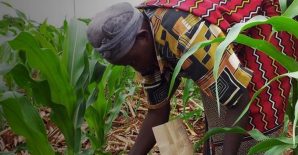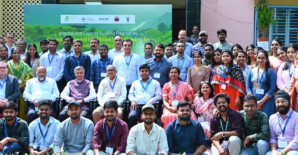Image copyright: Abdul Majeed/EU
The death and destruction from the catastrophic flooding in Pakistan over the summer has reignited the global debate on climate justice. There was a clear climate change signal in the extreme weather event: An unprecedented monsoon preceded by a drought, with the heaviest rainfall ever recorded in history, and overall five times the 30-year average. The resulting devastation in a country of 220 million—1,717 deaths, 33 million affected, widespread damage to infrastructure, crops, and livestock—was compounded by existing socioeconomic vulnerabilities.
The government estimates total losses from the disaster at PKR 6.2 trillion ($30.1 billion), and that recovery will cost PKR 3.5 trillion ($16.3 billion) in addition to $816 million for rescue and relief. The situation is exacerbated by continuing impacts of the COVID-19 pandemic and external shocks like the Russia-Ukraine conflict and macroeconomic crisis. Disaster relief and humanitarian aid is pouring into Pakistan, but not nearly at the levels required.
The 2022 IPCC Report outlines how vulnerabilities and existing patterns of inequity that turn climate hazards into disasters are linked to colonial legacies and current patterns of unsustainable development. Pakistan, like many other developing countries, is a case study in double injustice. Low-income countries have historically contributed a minuscule share of global greenhouse gases (GHGs), and thanks to long colonial histories, they inherited high levels of vulnerabilities and development deficits. Yet now they are bearing the brunt of global climate change impacts.
As the COP27 climate conference in Sharm El-Sheikh, Egypt (Nov. 6-18) approaches, Pakistan’s predicament has sparked rising calls for payments in some form from wealthy countries to affected low-income countries to address these structural inequities. In this post, we outline how the disaster is affecting the global climate justice debate and examine policy options for Pakistan’s difficult path toward recovery, and implications for other countries facing similar problems.
The path toward a global response on climate justice is uncertain at best; similar calls arose at COP26 in Glasgow last year, resulting only in the promise of a three-year dialogue on the topic. A 2009 pledge by developed countries to provide $100 billion for climate adaptation, meanwhile, has still not been honored.
Yet the Pakistan disaster could shake up that dynamic. Detailing the widespread devastation caused by the flooding, Pakistani Prime Minister Shahbaz Sharif has been vocal at global and regional forums about the country’s plight, Pakistan, which has contributed only 1% of global GHGs, Sharif said in an interview, is a “victim of something we have nothing to do with.” His outspokenness led to his being invited to assume the vice chairmanship of COP27. Pakistan is also chairing the G77 grouping of developing nations and China—which is calling for a finance facility to be created at COP27 to compensate countries for “loss and damage” to address harm from extreme weather events and rising sea levels.
Calls for a Loss and Damage approach are not new but have never really taken off. This time may be different, given the scale of disaster in Pakistan and the country’s resolute stand on the issue.
There are also calls for greater investment in renewable energy. Moreover, with both China and India now firmly in the top five GHG emitters on an absolute (but not per capita) basis, discussions around climate finance (and carbon budgets) are increasingly complex.
The situation in Pakistan and priority responses
As the linkages between these devastating floods and global warming become clearer and calls for high-emitting countries to take responsibility for climate change gain strength, the road to recovery for Pakistan will still be long and hard.1 The worst-hit regions are also some of its poorest, like rural Sindh and Balochistan, with limited access to health care and other infrastructure. The World Health Organization (WHO) has classified the floods as a Grade 3 emergency, its highest designation. Many displaced people living in camps and tents, around stagnant water (a breeding ground for disease-carrying mosquitoes) lack access to clean water and sanitation, with high numbers of cases of diarrhea, cholera, dengue, and malaria.
Given these immense needs and the possibly protracted and uncertain negotiations on climate finance at COP27, Pakistan must press on with its own responses to this extraordinary crisis. IFPRI research on the 2010 Pakistan floods, the 1998 Bangladesh floods, and the 2005 Pakistan earthquake presents some lessons for post-disaster recovery:
- Maintain domestic and international trade. This is essential for recovery to sustain food security and nutrition. Rebuilding trade-related infrastructure and trade policies that provide incentives for the private sector should be prioritized not only for agricultural staples but also for inputs including equipment and machinery. Pakistan gained from trade after the 2010 floods when imports helped stabilize market prices at import parity levels without creating an additional government spending burden, an important concern given the current macroeconomic situation in Pakistan. Similarly, in the aftermath of the 1998 Bangladesh floods, despite a drastic shortfall in rice production, a food crisis was averted because imports were maintained. However, as in 2010, today geopolitical frictions unfortunately hinder imports from optimal sources of supply, i.e., India with surplus for several food items.
- Include key affected sectors in large-scale disaster response (e.g., education, health, water and sanitation, transportation, communications, agricultural, trade, and industrial sectors) and involve all affected stakeholders (del Ninno et al 2001). In addition, even if emergency food relief is provided, continuing access to food remains a concern, given the widespread destruction of wealth and interruptions in income—the classic “entitlement problem” outlined by Amartya Sen. The destruction of livelihoods mandates complementary interventions of food and cash transfers and enhanced flow of formal credit through naturally expanding friend and family borrowing during and after disasters.
- Impacts on livelihoods should be a central focus in recovery, and policies should target solutions to avoid household indebtedness, a problem that can lead to dynamic propagation of shocks, a serious concern in Pakistan. Policies should include well-targeted food and income transfers buffered with credit provision.
- Rebuild infrastructure quickly, as it is crucial to economic livelihoods and will yield future benefits. The IFPRI study of the 2010 floods offers some important insights and showed that integrating rebuilding efforts into existing projects is more effective and has benefits also in terms of design of projects towards greater durability rather than being one-shot short term emergency response. It is preferable to integrate rebuilding efforts into existing infrastructure projects and budgets, which will help strengthen designs of future projects, and avoid making emergency rebuilding efforts stand-alone, one-off actions (World development report 2000-2001). Other investment shortfalls exist in waterways and in drainage and water storage systems.
- Invest in early warning systems. Flooding of this magnitude has revealed the lack of investment in EWS and more generally in disaster planning; for example, many people live in danger zones exposed to flooding and other hazards. While EWS may not avert a crisis, it could still save many lives and minimize economic losses. Such systems can also encourage stakeholders to develop better approaches to flood risk reduction and climate change adaptation (Cools et al, 2016; Turner et al 2014). After the 2010 floods, the government did announce new monitoring systems for glacier melt and floods for tributaries of the Indus, Working with disaster management authorities and the World Wildlife Fund (WWF), it also organized training on community-based EWS. Unfortunately, however, as in other cases of climate financing, pre-disaster risk management remains underfunded.
- Restore agricultural production. Given Pakistan’s large share of rural population (over 62%), this was an urgent priority after the 2010 floods and is now. The 2010 IFPRI research determined that the provision of seeds to smallholders and landless, along with replenishment of livestock assets, were important components of the recovery program. The study also identified the important role of NGOs in providing access to microcredit and in creating channels for emergency supplies needed for restoration. In these endeavors, selection of most vulnerable households through village committees or Provincial Disaster Management Authorities can minimize targeting errors.
Conclusions
We are already living in a 1.1°C warmer world. Given current emissions trends, the kind of devastating floods that hit Pakistan in 2022 will grow in both frequency and intensity as the world approaches 1.5°C of warming in a decade’s time; a climate-destabilized future is not far away. But it’s important to remember that neither the effects of climate change nor countries’ contributions to it are evenly distributed—thus the natural demands for climate justice in the runup to COP27.
The question to ask now in the aftermath of Pakistan floods is not only what the government and citizens of Pakistan can do (and they can do plenty to tackle vulnerabilities as outlined above). More importantly, it’s what the international community, and especially the historical emitters that have caused current climate change can do to 1) reduce emissions and reach net zero targets at the pace needed to keep the world below 1.5°C; and 2) create Loss and Damage mechanisms for climate compensation.
This disaster also reaffirms the ever-greater importance of agrifood trade in a climate-affected world, and the growing need for food system resilience. Evidence shows that trade significantly reduces the risks of food insecurity, because the world output of food staples typically varies only a little—much less than domestic outputs (Bradford et al, 2022)—enabling individual countries to achieve more consumption stability than if they were in autarky, and particularly when contending with disasters.
Going forward, continued long-term public investment in research and extension could further increase the efficiency of food systems and reduce their vulnerability to floods. Such investments must also give priority to improving disaster response and building climate resilience.
Pakistan has suffered a grievous blow; but how the country and world respond going forward can help chart a course toward a more equitable global approach to climate impacts, and for blunting the effects of future disasters on the most vulnerable countries.
The floods in Pakistan can be the spur for countries to work together at COP27 and accelerate collective climate action. Yet, getting climate financing on the agenda at COP 27 will require building consensus and minimizing pushback from high-income countries called upon to pay. Acting sooner rather than later is crucial. Moving from planning to implementation, then adaptation, vulnerability reduction, and strengthening resilience will only get costlier if COP27 participants do not seize this opportunity. At minimum, honoring the $100 billion/year commitment would be a good start.
Aditi Mukherji is Director of the CGIAR Climate Change Impact Area Platform; Abdul Wajid Rana is Program Leader of IFPRI's Pakistan Strategy Support Program; Devesh Roy is a Senior Research Fellow with IFPRI's South Asia Region.
This blog was first published here.
1. Research has also expanded that links extreme weather events to climate change (World Weather Attribution) and on the connections between sources of pollution and impacts on those exposed. The Lancet estimated that heavy rainfall in Pakistan was linked to climate change inter alia by the melting of several glaciers.
IFPRI estimates suggest that by 2030, an additional 70 million will be at risk of hunger because of climate change.
Over a quarter of century, just the US emissions could be attributed to $33 billion of lost growth in Pakistan (Callahan and Mankin 2022).



